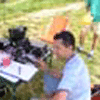GB4PV MV PRINCESS VICTORIA

COMMERORATING 60 YEARS OF THE SINKING OF THE
MV PRINCESS VICTORIA 31st JANUARY 1953 - 2013
MV Princess Victoria was one of the earliest roll-on/roll-off (ro-ro) ferries. Built in 1947, she operated from Stranraer to Larne. During a severe European windstorm on 31 January 1953, she sank in the North Channel with the loss of 133 lives. This was then the deadliest maritime disaster in United Kingdom waters since World War 2
.Princess Victoria was employed by British Railways on the crossing from Stranraer in Scotland to Larne in Northern Ireland.
Captained by the 55 year old James Ferguson, the vessel left Stranraer's railway loading pier at 07:45 AM with 44 tons of cargo, 128 passengers and 51 crew. Captain Ferguson had served as master on various ferries on the same route for 17 years. A gale warning was in force but he made the decision to put to sea. Loch Ryan is a sheltered inlet and the immediate force of the wind and sea was not apparent, but it was noted that spray was breaking over the stern doors. A "guillotine door" had been fitted because of the previously identified problem with spray and waves hitting the stern doors, but it was rarely used because it took too long to raise and lower. This would have provided extra protection for the sliding stern doors. On this occasion it was not lowered.
Shortly after clearing the mouth of Loch Ryan, the ship turned west towards Larne and exposed her stern to the worst of the high seas. Huge waves damaged the low stern doors, allowing water to enter the car deck. The crew struggled to close the doors again but they proved to be too badly damaged and water continued to flood in from the waves. The scuppers did not seem to be allowing the water to drain away. The ship took a list to starboard and at this point Captain Ferguson decided to retreat to the safety of Loch Ryan by going astern and using the bow rudder. This proved to be impossible, because the extreme conditions prevented the deckhands from releasing the securing pin on the bow rudder, and the Captain then made a decision to try to reach Northern Ireland by adopting a course which would keep the stern of the craft sheltered from the worst of the elements. At 09:46 AM, two hours after leaving Stranraer a message was transmitted in Morse code (the Princess Victoria did not have a radio telephone) to the Portpatrick Radio Station: "Hove-to off mouth of Loch Ryan. Vessel not under command. Urgent assistance of tugs required". With a list to starboard exacerbated by shifting cargo, water continued to enter the ship. At 10:32 AM an SOS transmission was made, and the order to abandon was given at 14:00.
Upon the upgrade of the assistance message to an SOS, the Portpatrick Lifeboat the Jeannie Spiers was dispatched as was the destroyer HMS Contest. Contest, commanded by Lt Commander HP Fleming, left Rothesay at 1109hrs but although she came close to her position at 1330hrs, poor visibility prevented the crew from seeing the sinking ship. The destroyer had been trying to maintain a speed of 31 knots (57 km/h; 36 mph) to reach the listing ferry but after sustaining damage from the seas Captain Fleming was forced to reduce speed to 16 knots (30 km/h; 18 mph).
The Princess Victoria was still reporting her position as 5 miles north west of Corsewall Point but her engines were still turning and even at the speed of 5 knots (9.3 km/h; 5.8 mph) were gradually drawing the vessel closer to Northern Ireland and away from her reported position. At 1308hrs the ship broadcast that her engines had stopped. The final morse code message at 1358hrs reported the ship "on her beam end" 5 miles east of the Copeland Islands.
The ship's radio officer, David Broadfoot, was posthumously awarded the George Cross for staying at his post to the very end, allowing passengers and crew to escape, even though by doing so he was preventing his own escape. His medal is on permanent display in Stranraer Museum.
The George Medal was awarded to the ship's captain, James Ferguson (posthumously), and a number of people involved in the rescue operation. Captain Ferguson was observed by those in the water or in lifeboats to be stood at the salute on the bridge in the classic pose of the captain who goes down with his ship.










